A unique teaching method using memory-boosting techniques in Dundee has been awarded a £500,000 grant.
Experts at Abertay and Dundee universities have been working together to research, “self-referencing”, which helps children understand a problem by putting themselves into situations.
A study of 500 children across Scotland will examine how the technique can help maths, language and general learning. It is hoped this will lead to a learnng resource for parents, teachers and children.
Lead researcher Dr Sheila Cunningham, from Abertay’s division of psychology and forensic sciences, said: “We know that relating something to yourself benefits the memory in both adults and children so it makes sense to apply this to education.
“Maths word problems are often text heavy. We all remember questions like ‘Billy has four eggs. Jane has three eggs more than Billy. How many eggs does Jane have?’
“Questions worded in this way can be a significant barrier for children. It means they have to keep track of the characters of Billy and Jane as well as the numbers, giving them extra information to retain and follow.
“Early evidence suggests that incorporating the child into the question makes it easier to solve. So we would say: ‘You have four eggs, and Jane has three eggs more than you’ instead. This reduces the amount of information the child has to retain, and also links the information to their sense of self, which supports memory.”
The grant for the three-year study has been awarded by the Economic and Social Research Council (ESRC), part of UK Research and Innovation.









